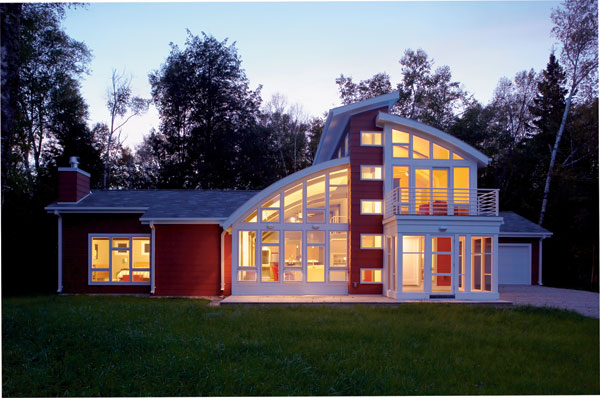
Because this Sturgeon Bay home faces not just the lake but also a road, the architect deliberately created a design that would have maximum night-time drama for passersby. The master suite is set at the left end to give it some privacy; upstairs on the right, two additional bedrooms accommodate the homeowners’ daughters.
People who want to build green in heavily populated urban areas can only do so much. "Where we live, there’s no open land," says an Evanston woman who, like her husband, is a Chicago media professional. "Building is a very expensive proposition because you have to tear down a house." But when the couple had a chance to buy a beautiful property in Door County, Wisconsin, they realized they had an opportunity to do something special. "It made a lot of sense," she says.
Now they had the chance to make their second home, about a four-hour drive from the city, a green paradise.
The couple hired Evanston-based architect Nathan Kipnis, a leading practitioner of sustainable design, to come up with something for the Sturgeon Bay site. With budgetary constraints as the only limitation, they gave him free rein with the design-which Kipnis found a bit intimidating at first. "When you have the freedom to do anything you want, where do you start?" he asks. In this case, with the land itself, much of which was heavily wooded. The east side, however, opened up to an entirely unobstructed view of Lake Michigan, lapping the shore less than 300 feet from where the house would stand.
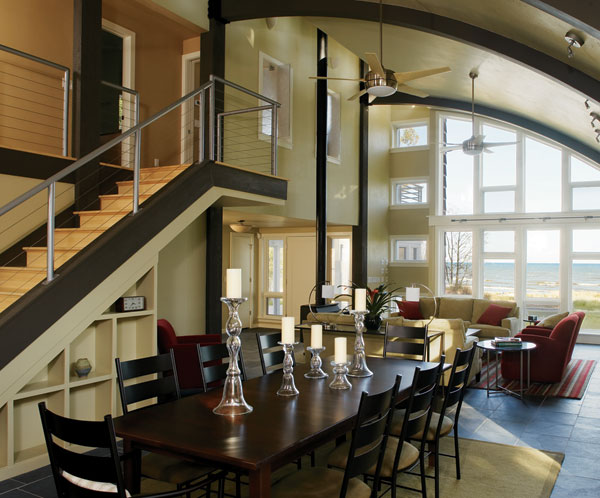
A wood-burning stove (between the two couches in the living room area) wards off cold air from the front door during the winter; its flue extends up through the ventilation tower that draws warm air up and out during the summer.
Taking advantage of the ample shade and lake breezes, Kipnis envisioned a home so well ventilated, it wouldn’t need air conditioning. The cornerstone of his design is the ventilation tower, a tall, narrow section that runs through the center of the home. It’s stacked with east-facing windows; the lower ones draw in cool air, while the ones at the top (operated by remote control) pull up hot air and push it out. Distinctive curved-roofed sections on both sides of the tower are a playful touch, but they also serve a highly practical purpose. "There’s a reason barn roofs are shaped like that-they make the air go up and out," Kipnis points out.
They also give a cathedral-like feeling to the great room-comprising the living room, dining room, and kitchen-and belie the home’s relatively modest 2,500 square feet of space. Facing east is the living room, where a wall of high-performance windows overlooks the lake and supplements the cooling power of the ventilation tower. The deck outside was built just a step up from the ground, to avert the need for view-obstructing railings. Surrounding the home is a lawn of NoMowGrass, a short-growing grass that requires very little water.
At the back of the great room is the kitchen, a room that typically offers many opportunities to be green. But the wife says that putting their ethics into practice turned out to be harder than expected. "Two to three years ago, when we started this process," she recalls, "the construction industry and its suppliers were for the most part not green and in some cases simply had no clue. There was an appliance salesman on the North Shore who actually told us he had never before had a customer ask him if the refrigerator was Energy Star!"
That’s rather surprising, given that the Energy Star designation has been around for more than a decade; it shows that a product or building has met stringent energy-efficiency guidelines set by the U.S. Environmental Protection Agency and Department of Energy. So the homeowner got online to research options and was thrilled to discover that Greenmaker Building Supply, a one-stop green superstore, had just opened on the Northwest Side.
"The company had young, excited owners who were clearly committed to helping Chicago homeowners find green products," she says. "We were as excited to support their new business as they were to have their first customers." One of the store’s designers helped the couple create a simple, efficient kitchen with a poured concrete counter and formaldehyde-free cabinets made from bamboo, a readily renewable resource.
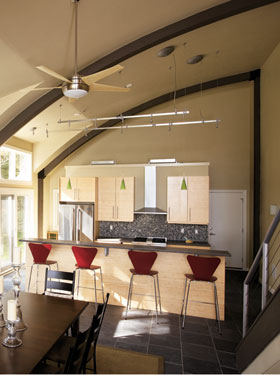 |
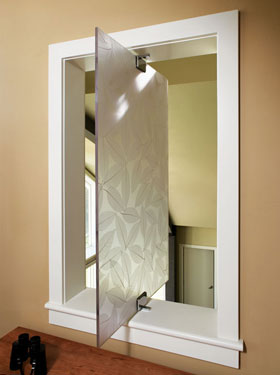 |
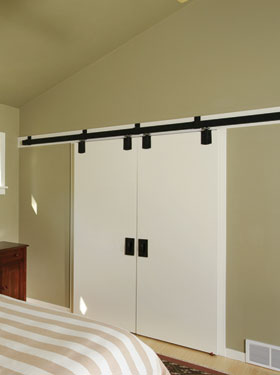 |
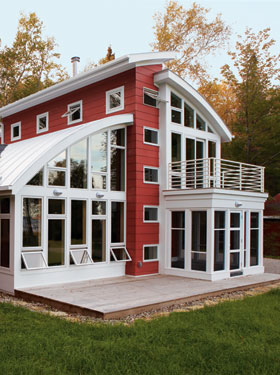 |
|
(Clockwise from top left) Tucked behind the back wall of the kitchen are a pantry at one end and a storage closet at the other. In the upstairs bedrooms, eco-friendly resin panels swing open on shower-door pivots. Red was the only color ever considered for the cement fiberboard siding. Mounting the master suite closet doors on barn-door tracks lends a modern edge. |
|
Bamboo also was used for the floors in the master bedroom as well as the two upstairs bedrooms, which accommodate the owners’ daughters; the rest of the floors are slate. The floors have a radiant heating system installed under them, which makes good environmental sense, allowing the occupants to set the thermostat lower than they otherwise would. "If your feet are warm, you’re happy as can be," Kipnis explains. "You can set a radiant floor at 67 or 68 degrees and it feels like 72. And the best thing is, the colder it is outside, the hotter your floors are, because they’re working harder to heat the house." Warm floors mean there’s no need for carpeting, which typically collects dust mites and lowers indoor air quality; they also mean no dust or drafts blowing through the house from forced-air heat.
Other green elements of the home include high-density insulation made largely from recycled paper and soy oil, paints and finishes with no or low V.O.C.s low-flow water faucets and fixtures, and a roof that’s ready for solar panels in the future-adding up to the highest level of Energy Star certification. In fact, the rater said he’d never seen a green home done so well.
"Our office is really, really proud of it," Kipnis says. Pointing toward the collection of sports banners hanging from the rafters of his office, he adds, "I always look at this banner up here, which is the Bulls championship banner. Those"-he motions to two banners with photos of the Sturgeon Bay house-"are the first of our championship banners."
photography by wayne cable


